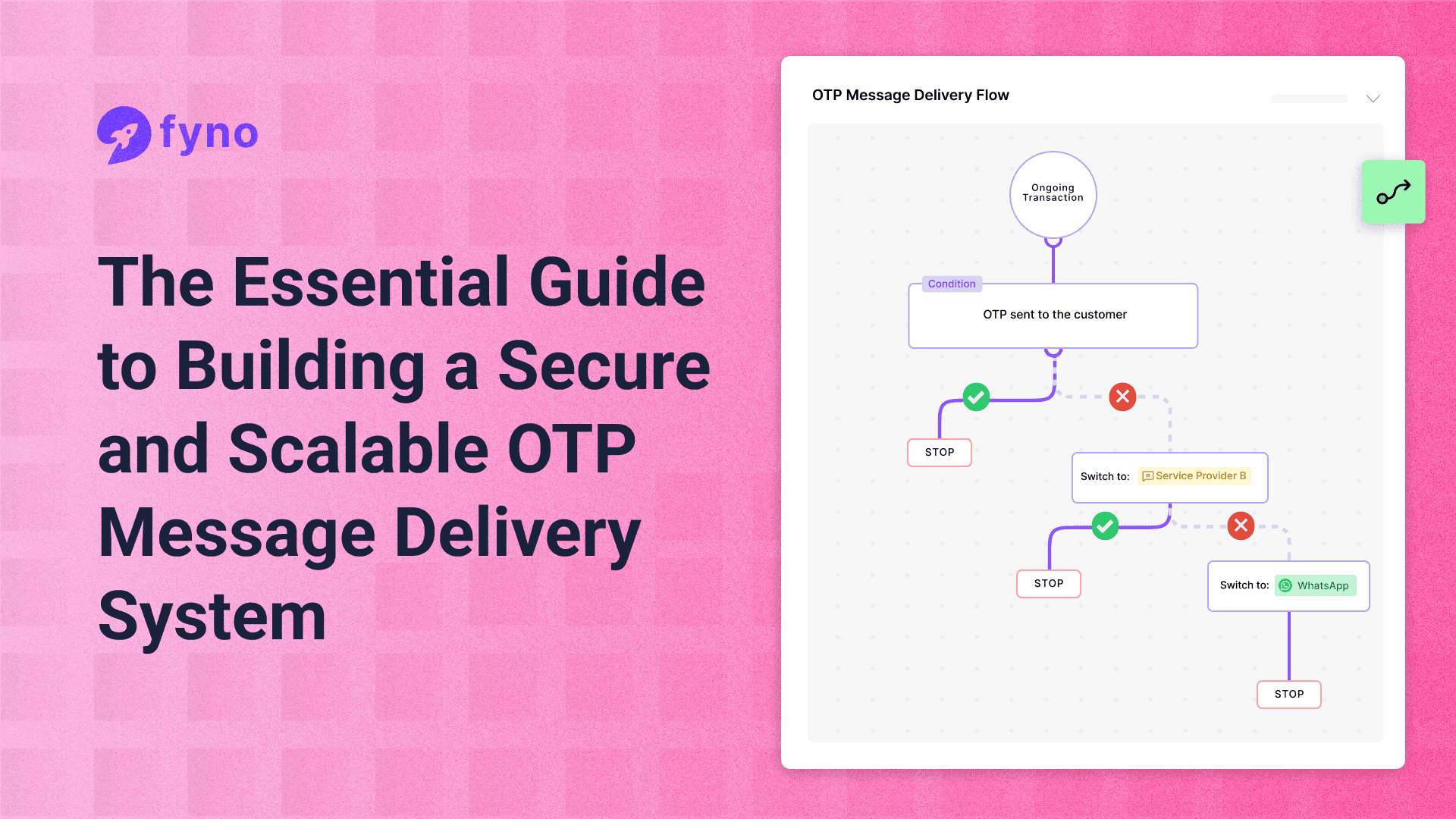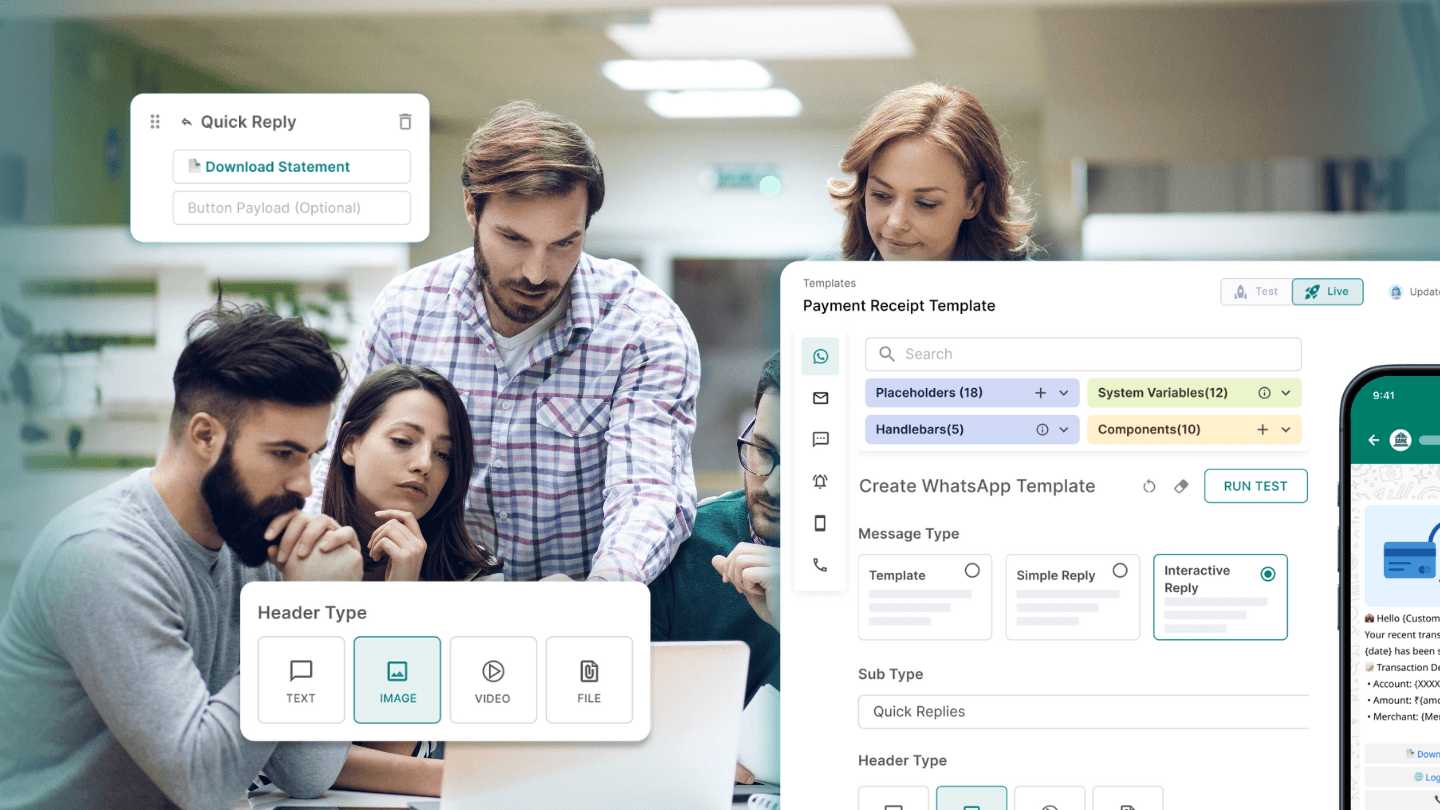In India, OTP means trust. With billions of e-commerce and banking transactions happening each year, several millions lost in fraud and scams, and a large portion of the country's population not being tech-savvy, the only line of defense that stands between the people and their products or money is an OTP message.

What is an OTP?
OTP or One-time Password is a type of authentication where a unique code is sent to the user via SMS, email, WhatsApp, or push notification before they attempt to log into their account or complete a transaction in order to verify their identity. In most cases, OTPs are used as an additional authentication mechanism apart from the user’s password. OTPs are also known as 2FA (2-Factor Authentication) or One-Time Pin in different parts of the world.
Common use cases for OTP messages
OTP messages, or One-Time Passwords, are commonly used for the following scenarios:
- Ticket booking
- Money transfer
- Delivery of high-value goods
- Service initiation and completion
- Address or phone number change
- Logging into government portals
- International transactions
- Ride-hailing apps
OTP message delivery channels
There are several channels for sending OTP messages, each with its pros and cons:
- SMS: Simple, fast, and reliable — the reason it is one of the most commonly used authentication methods by banks, financial institutions, and other government bodies. The only issue is that SMS campaigns have a 98% delivery rate. But when it comes to delivering OTP messages, the success rate should be 100%. So, many businesses use a combination of channels to deliver OTPs.
- Email: Many businesses and service providers use email as an additional authentication channel besides SMS authentication. This is helpful in scenarios where the user travels abroad and doesn't have access to their mobile number or network. Outside of this, many B2B software companies use email as their only channel to send OTP messages for login and password reset.
- WhatsApp: A recent yet widely adopted and fast-growing channel for delivering OTP messages, especially used by e-commerce businesses and D2C brands to send OTPs that need to be shared with the delivery partner.
- Push/In-App Notifications: Push/in-app notifications are commonly used by ride-hailing apps, home services companies, food delivery businesses, etc., to track the beginning/end of a transaction. However, as a backup, these companies even use another channel, such as SMS, to deliver OTP messages.
What should you look for in a scalable, robust, OTP message delivery system?
To build a robust and scalable OTP message delivery system, you need to look at the following factors.
100% deliverability
Ensuring that all OTP messages are actually delivered to users is paramount. This requires close integration with reliable service providers and continuous monitoring. Undelivered OTP messages might not allow the users to complete their transaction, and hence will lead to user frustration and churn.
Real-time delivery
OTP messages need to arrive almost instantly. Because refreshing the messages app and waiting for the OTP, or clicking the “Resend OTP” option to receive a couple of transactional messages for the same process and not knowing which one to use, is a frustrating experience. Delays in receiving OTPs can result in loss of revenue, added logistics cost, or cart abandonment. So, businesses will have to choose delivery channel(s) that are optimized for speed and have a track record for performance.
Callback management
The OTP system should have the necessary systems in place to gracefully handle delivery failures and retry sending the OTP message.
Failover protocols
A robust OTP delivery system shouldn’t rely on a single delivery method. It needs to have an automated failover system that switches to a secondary provider or an alternate channel if the primary channel is unresponsive or throttled. This maximizes successful delivery of OTP messages.
Observability
The best way to optimize the performance of a message delivery system is by getting real-time visibility into the entire OTP message delivery flow. The system you have in place should allow you to monitor key metrics like delivery rate, latency, and failures, and alert on any degradations or issues in performance for proactive resolution.
Scalability
The system you have in place should be instantly scalable based on demand. Because, in a consumer business the transaction volume can go up or down based on various factors like the time of the month, season, festivals, etc. So, having an OTP delivery system that scales with the demand without requiring any additional developer assistance is a must-have for businesses.
Fyno: Your intelligent OTP message delivery platform
Building a robust and scalable OTP message delivery system in-house is complex and resource-intensive. That's where Fyno comes in — a smart opti-channel solution designed to streamline your OTP workflows. Fyno is built to excel at all the key parameters we’ve discussed above. Let’s look at them one by one.
- Guaranteed deliverability: Fyno's direct integration with leading service providers, ensures reliable delivery of your OTP messages via SMS. And, being a Meta-verified tech partner, Fyno makes it easy and effortless in helping you integrate WhatsApp as an alternate channel for OTP message delivery. You can add multiple service providers, and our intelligent routing engine dynamically selects the optimal service providers or channels based on real-time delivery metrics, pushing your success rate to 100% deliverability.
- On-time delivery, every time: Fyno’s zero-latency architecture ensures near-instant OTP message delivery. Give your users the immediate, frictionless authentication experience they expect, driving higher conversion and satisfaction.
- Automated failover systems: Never miss a critical OTP message again. Fyno continuously monitors the health and responsiveness of each delivery channel, automatically switching to a backup option if the primary one is underperforming or unresponsive. You can choose the backup option to be another service provider or a different communication channel based on the scenario. You can also create multiple workflows based on the type of customer, their location, or their communication preferences.
- Granular observability: Take the guesswork out of your OTP message flows. Fyno provides intuitive, real-time dashboards displaying key metrics like delivery rate, latency, and failures across all your channels. Use our logs and reports to identify and resolve any issues before they impact your users.
- Effortless scalability: Whether you're sending a hundred OTP messages or a hundred million, Fyno scales effortlessly with your business. Our rigorously tested platform is designed to handle massive volumes without breaking a sweat.
- Seamless integration: Fyno works with your existing authentication systems, not against them. Our flexible APIs and webhooks make integration a breeze, so you can start supercharging your OTP message delivery in no time.
By leveraging Fyno's state-of-the-art notification infrastructure platform, you can provide your users with a lightning-fast, frictionless OTP authentication experience.
Ready to streamline your OTP message delivery and give your users the world-class authentication experience they deserve? Get in touch with us for a personalized demo and see how Fyno can transform your OTP message flows.


